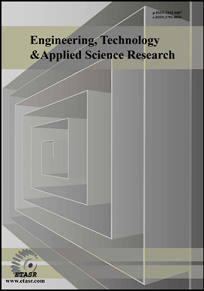Interface Microstructure Investigation of Babbitt-Carbon Steel Composite Using Flux with Glycerol and Petroleum Jelly Additives
Abstract
The influence of adding glycerol and petroleum jelly during the tinning process of steel shell base of Babbitt-steel bimetal is studied in this paper. The morphology of interface layer is changed from a discontinuous layer in case of using flux+tin to a continuous one by adding glycerol or petroleum jelly to the flux+tin mixture. Also, the nterface layer thickness and the unbonded interface layer area increase by adding glycerol or petroleum jelly to flux+tin mixture due to their physical properties.
Keywords:
Babbitt, steel, flux, glycerol, petroleum jellyDownloads
References
T. Wróbel, “Characterization of Bimetallic Castings with an Austenitic Working Surface Layer and an Unalloyed Cast Steel Base”, Journal of Materials Engineering and Performance, Vol. 23, No. 5, pp. 1711–1717, 2014 DOI: https://doi.org/10.1007/s11665-014-0953-4
M. Ramadan, K. M. Hafez, K. S. Abdel Halim, N. Fathy, T. Chiba, H. Sato, Y. Watanabe, “Influence of Heat Treatment on Interface Structure of StainlessSteel/Gray Iron Bimetallic Layered Castings”, Applied Mechanics and Materials, Vol. 873, pp. 3-8, 2017 DOI: https://doi.org/10.4028/www.scientific.net/AMM.873.3
M. Ramadan, “Interface Characterization of Bimetallic Casting with a 304 Stainless Steel Surface Layer and a Gray Cast Iron Base”, Advanced Materials Research, Vol. 1120-1121, pp. 993-998, 2015 DOI: https://doi.org/10.4028/www.scientific.net/AMR.1120-1121.993
R. R. Dean, C. J. Eavans, “Plain bearing materials: the role of tin”, Tribology International,Vol. 9, No. 3, pp. 101–108, 1976 DOI: https://doi.org/10.1016/0301-679X(76)90032-3
G. C. Pratt, “Materials for plain bearings”, International Metallurgical Reviews,Vol. 18, No. 2, pp. 62–88, 1973 DOI: https://doi.org/10.1179/imtlr.1973.18.2.62
M. Moazami Goudarzi, S. A. Jenabali Jahromi, A. Nazarboland, “Investigation of characteristics of tin-based white metals as a bearing material”, Materials and Design, Vol. 30, No. 6, pp. 2283–2288, 2009 DOI: https://doi.org/10.1016/j.matdes.2008.07.056
P. Diouf, A. Jones, “Investigation of Bond Strength in Centrifugal Lining of Babbitt on Cast Iron” Metallurgical And Materials Transactions A, Vol. 41, No. 3, pp. 603-609, 2010 DOI: https://doi.org/10.1007/s11661-009-0112-y
P. K. Liaw, M. N. Gungor, W.A. Logsdon, Y. Ijiri, B. J. Taszarek, S. Frohlich, “Effect of Phase Morphologies on the Mechanical Properties of Babbitt-Bronze Composite Interfaces”, Metallurgical Transactions A, Vol. 21, No. 2, pp. 529-538, 1990 DOI: https://doi.org/10.1007/BF02671925
N. Fathy, M. Ramadan, “Influence of Vol. Ratio of Liquid to Solid and Low Pouring Temperature on Interface Structure of Cast Babbitt-Steel Bimetal Composite”, AIP Conference Proceedings 1966, pp. 020028-1- 020028-6, AIP Publishing, 2018 DOI: https://doi.org/10.1063/1.5038707
A. G. Gromyko, “Influence of Casting Method of Plain Bearings on the Structure of Babbitt”, Metal Science and Heat Treatment, Vol. 32, No. 9, pp. 708-711, 1990 DOI: https://doi.org/10.1007/BF00693342
J. Wang, Q. Xia, Y. Ma, F. Meng, Y. Liang, Z. Li, “Interfacial Bonding Energy on the Interface between ZChSnSb/Sn Alloy Layer and Steel Bodyat Microscale”, Materials, Vol. 10, No. 10, p. 1128, 2017 DOI: https://doi.org/10.3390/ma10101128
J. Koutsky, J. Vesela, “Evaluation of white metal adhesion (conventional casting and thermal wire arc spraying) by ultrasonic non-destructive method”, Journal of Materials Processing Technology , Vol. 157–158, pp. 724–728, 2004 DOI: https://doi.org/10.1016/j.jmatprotec.2004.07.131
Downloads
How to Cite
License
Authors who publish with this journal agree to the following terms:
- Authors retain the copyright and grant the journal the right of first publication with the work simultaneously licensed under a Creative Commons Attribution License that allows others to share the work with an acknowledgement of the work's authorship and initial publication in this journal.
- Authors are able to enter into separate, additional contractual arrangements for the non-exclusive distribution of the journal's published version of the work (e.g., post it to an institutional repository or publish it in a book), with an acknowledgement of its initial publication in this journal.
- Authors are permitted and encouraged to post their work online (e.g., in institutional repositories or on their website) after its publication in ETASR with an acknowledgement of its initial publication in this journal.

